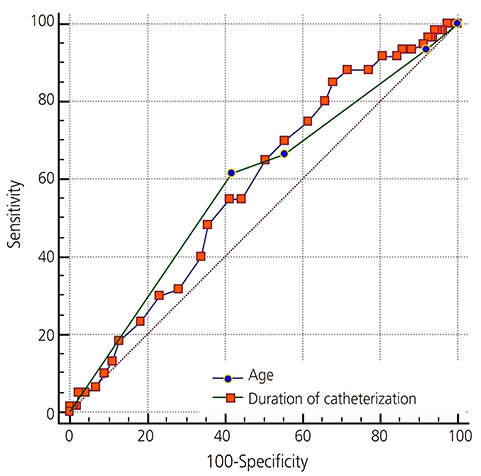Obstet Gynecol Sci.
2016 Mar;59(2):137-143. 10.5468/ogs.2016.59.2.137.
Risk factors for urinary retention after vaginal hysterectomy for pelvic organ prolapse
- Affiliations
-
- 1Department of Obstetrics and Gynecology, Seoul National University Hospital, Seoul, Korea.
- 2Department of Obstetrics and Gynecology, Seoul National University Bundang Hospital, Seongnam, Korea. blasto@snubh.org
- 3Department of Obstetrics and Gynecology, Seoul National University College of Medicine, Seoul, Korea.
- KMID: 2159009
- DOI: http://doi.org/10.5468/ogs.2016.59.2.137
Abstract
OBJECTIVE
To evaluate the risk factors for postoperative urinary retention in women who underwent vaginal hysterectomy for symptomatic pelvic organ prolapse.
METHODS
The medical records of 221 women who underwent vaginal hysterectomy with anterior and posterior colporrhapy were reviewed. Urinary retention after catheter removal was defined as the presence of at least one of the following three conditions: 1) failure of first voiding trial necessitating catheterization, 2) first residual urine volume after self-voiding ≥150 mL, and 3) Foley catheter re-insertion.
RESULTS
Urinary retention occurred in 60 women (27.1%). Multivariate and receiver operating characteristic curve analysis revealed that age (>63 years) and early postoperative day of catheter removal (day 1) was independent predictor for postoperative urinary retention. The incidence of urinary retention was significantly higher in women who removed indwelling catheter at day 1 (35.2%) than those at day 2 (12.0%, P=0.024), or day 3 (21.3%, P=0.044), but was similar to those at day 4 (25.0%, P=0.420). In women ≤63 years, urinary retention rate was not associated with the time of catheter removal after surgery; however, in women >63 years, the rate was significantly higher in day 1 removal group than day 2 to 4 removal group.
CONCLUSION
Age and postoperative day of catheter removal appear to be associated with postoperative urinary retention in women undergoing vaginal hysterectomy for pelvic organ prolapse. Keeping urinary catheter in situ at least for one day after vaginal prolapse surgery could be recommended, especially, in women older than 63 years.
Keyword
MeSH Terms
Figure
Cited by 1 articles
-
Outcomes of vaginal hysterectomy combined with anterior and posterior colporrhaphy for pelvic organ prolapse: a single center retrospective study
Ju Hee Kim, So Young Lee, Hee Dong Chae, Yoon Kyung Shin, Sa Ra Lee, Sung Hoon Kim
Obstet Gynecol Sci. 2022;65(1):74-83. doi: 10.5468/ogs.21235.
Reference
-
1. Fernandez RS, Griffiths RD. Duration of short-term indwelling catheters: a systematic review of the evidence. J Wound Ostomy Continence Nurs. 2006; 33:145–153.2. Ghezzi F, Uccella S, Cromi A, Bogani G, Candeloro I, Serati M, et al. Surgical treatment for pelvic floor disorders in women 75 years or older: a single-center experience. Menopause. 2011; 18:314–318.3. Hakvoort RA, Dijkgraaf MG, Burger MP, Emanuel MH, Roovers JP. Predicting short-term urinary retention after vaginal prolapse surgery. Neurourol Urodyn. 2009; 28:225–228.4. Liang CC, Lee CL, Chang TC, Chang YL, Wang CJ, Soong YK. Postoperative urinary outcomes in catheterized and non-catheterized patients undergoing laparoscopic-assisted vaginal hysterectomy: a randomized controlled trial. Int Urogynecol J Pelvic Floor Dysfunct. 2009; 20:295–300.5. Keita H, Diouf E, Tubach F, Brouwer T, Dahmani S, Mantz J, et al. Predictive factors of early postoperative urinary retention in the postanesthesia care unit. Anesth Analg. 2005; 101:592–596.6. Segev Y, Auslender R, Lissak A, Lavie O, Abramov Y. Symptomatic pelvic hematoma following transvaginal reconstructive pelvic surgery: incidence, clinical presentation, risk factors, and outcome. Eur J Obstet Gynecol Reprod Biol. 2010; 153:211–214.7. Alonzo-Sosa JE, Flores-Contreras JT, Paredes-Canul M. Method for transurethral catheterization for 1-3 days for pelvic floor relaxation in the postoperative period. Ginecol Obstet Mex. 1997; 65:455–457.8. Hakvoort RA, Elberink R, Vollebregt A, Ploeg T, Emanuel MH. How long should urinary bladder catheterisation be continued after vaginal prolapse surgery? A randomised controlled trial comparing short term versus long term catheterization after vaginal prolapse surgery. BJOG. 2004; 111:828–830.9. Kamilya G, Seal SL, Mukherji J, Bhattacharyya SK, Hazra A. A randomized controlled trial comparing short versus long-term catheterization after uncomplicated vaginal prolapse surgery. J Obstet Gynaecol Res. 2010; 36:154–158.10. Nicolle LE. Catheter-related urinary tract infection. Drugs Aging. 2005; 22:627–639.11. Dunn TS, Shlay J, Forshner D. Are in-dwelling catheters necessary for 24 hours after hysterectomy? Am J Obstet Gynecol. 2003; 189:435–437.12. Phipps S, Lim YN, McClinton S, Barry C, Rane A, N'Dow J. Short term urinary catheter policies following urogenital surgery in adults. Cochrane Database Syst Rev. 2006; (2):CD004374.13. Toyonaga T, Matsushima M, Sogawa N, Jiang SF, Matsumura N, Shimojima Y, et al. Postoperative urinary retention after surgery for benign anorectal disease: potential risk factors and strategy for prevention. Int J Colorectal Dis. 2006; 21:676–682.14. Alessandri F, Mistrangelo E, Lijoi D, Ferrero S, Ragni N. A prospective, randomized trial comparing immediate versus delayed catheter removal following hysterectomy. Acta Obstet Gynecol Scand. 2006; 85:716–720.15. Moore T, Tubman I, Levy G, Brooke G. Age as a risk factor for perioperative complications in women undergoing pelvic reconstructive surgery. Female Pelvic Med Reconstr Surg. 2010; 16:290–295.16. Chancellor M, Yoshimura N. Physiology and pharmacology of the bladder and urethra. In : Campbell MF, Retik AB, Walsh PC, editors. Campbell's urology. Philadelphia (PA): Saunders;2002. p. 831–886.17. Malone-Lee J, Wahedna I. Characterisation of detrusor contractile function in relation to old age. Br J Urol. 1993; 72:873–880.
- Full Text Links
- Actions
-
Cited
- CITED
-
- Close
- Share
- Similar articles
-
- Surgical treatments for vaginal apical prolapse
- Five cases of abdominal sacral colpopexy for the vaginal vault prolapse after total hysterectomy
- Vaginal Approaches Using Synthetic Mesh to Treat Pelvic Organ Prolapse
- Incidence of Concomitant Procedures for Pelvic Organ Prolapse and Reconstruction in Women Who Undergo Sling Operation for Stress Urinary Incontinence
- Four Cases of Repair of Post Hysterectomy Vaginal Vault Prolapse


